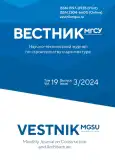Метод расчета геометрических параметров конструкций атриума здания с учетом комфорта температурно-воздушного режима
- Авторы: Тхам Ф.Т.1,2,3, Зыонг Д.Т.4, Соловьев А.К.3
-
Учреждения:
- Технологический университет Хошимина
- Вьетнамский национальный университет Хошимина
- Национальный исследовательский Московский государственный строительный университет (НИУ МГСУ)
- Университет Тран Дай Нгиа
- Выпуск: Том 19, № 3 (2024)
- Страницы: 349-357
- Раздел: Архитектура и градостроительство. Реконструкция и реставрация
- URL: https://journals.rcsi.science/1997-0935/article/view/255898
- ID: 255898
Цитировать
Полный текст
Аннотация
Об авторах
Фам Тхи Хонг Тхам
Технологический университет Хошимина; Вьетнамский национальный университет Хошимина; Национальный исследовательский Московский государственный строительный университет (НИУ МГСУ)
Email: ptham0825@gmai.com
ORCID iD: 0000-0002-7418-2084
SPIN-код: 9515-2143
Де Тай Зыонг
Университет Тран Дай Нгиа
Email: duongdetai@gmail.com
А. К. Соловьев
Национальный исследовательский Московский государственный строительный университет (НИУ МГСУ)
Email: kafedraarxitektury@yandex.ru
SPIN-код: 3821-9431
Список литературы
- Hung W.Y., Chow W.K. A review on architectural aspects of atrium buildings // Architectural Science Review. 2001. Vol. 44. Issue 3. Pp. 285–295. doi: 10.1080/00038628.2001.9697484
- Moosavi L., Mahyuddin N., Ab Ghafar N., Ismail M.A. Thermal performance of atria: An overview of natural ventilation effective designs // Renewable and Sustainable Energy Reviews. 2014. Vol. 34. Pp. 654–670. doi: 10.1016/j.rser.2014.02.035
- Acred A., Hunt G.R. Stack ventilation in multi-storey atrium buildings: A dimensionless design approach // Building and Environment. 2014. Vol. 72. Pp. 44–52. doi: 10.1016/j.buildenv.2013.10.007
- Wang L., Huang Q., Zhang Q., Xu H., Yuen R.K.K. Role of atrium geometry in building energy consumption: the case of a fully air-conditioned enclosed atrium in Cold Climates, China // Energy and Buildings. 2017. Vol. 151. Pp. 228–241. doi: 10.1016/j.enbuild.2017.06.064
- Aldawoud A. The influence of the atrium geometry on the building energy performance // Energy and Buildings. 2013. Vol. 57. Pp. 1–5. doi: 10.1016/j.enbuild.2012.10.038
- Abdullah A.H., Wang F. Modelling thermal stratification in atrium using TAS program and verification of prediction results // International Journal of Integrated Engineering. 2009. Vol. 1. Issue 2. Pp. 79–93.
- Moosavi L., Mahyuddin N., Ab Ghafar N., Ismail M.A. Thermal performance of atria: An overview of natural ventilation effective designs // Renewable and Sustainable Energy Reviews. 2014. Vol. 34. Pp. 654–670. doi: 10.1016/j.rser.2014.02.035
- Крашенинникова Т.С., Гришкова А.В. Анализ параметров микроклимата в здании с атриумом в заданных климатических условиях с использованием программы ANSYS FLUENT // Вестник Пермского национального исследовательского политехнического университета. Прикладная экология. Урбанистика. 2016. № 4 (24). С. 46–61. doi: 10.15593/2409-5125/2016.04.04.EDNUUZFAB.
- Табунщиков Ю.А., Бродач М.М., Шилкин Н.В. Энергоэффективные здания : учебное пособие. М. : АВОК-пресс, 2003. 192 c.
- Aldawoud A. The influence of the atrium geometry on the building energy performance // Energy and Buildings. 2013. Vol. 57. Pp. 1–5. doi: 10.1016/j.enbuild.2012.10.038
- Holford J.M., Hunt G.R. Fundamental atrium design for natural ventilation // Building and Environment. 2003. Vol. 38. Issue 3. Pp. 409–426. doi: 10.1016/S0360-1323(02)00019-7
- Wang X., Huang C., Cao W. Mathematical modeling and experimental study on vertical temperature distribution of hybrid ventilation in an atrium building // Energy and Buildings. 2009. Vol. 41. Issue 9. Pp. 907–914. doi: 10.1016/j.enbuild.2009.03.002
- Holford J.M., Hunt G.R. Fundamental atrium design for natural ventilation // Building and Environment. 2003. Vol. 38. Issue 3. Pp. 409–426. doi: 10.1016/S0360-1323(02)00019-7
- Zhang M., Li N., Zhang E., Hou S., He D., Li J. Effect of atrium size on thermal buoyancy-driven ventilation of high-rise residential buildings: A CFD study // Proceedings — 6th International Symposium on Heating, Ventilating and Air Conditioning, ISHVAC. 2009. Vol. 2. Pp. 1240–1247.
- Moosavi L., Mahyuddin N., Ghafar N. Atrium cooling performance in a low energy office building in the Tropics, a field study // Building and Environment. 2015. Vol. 94. Pp. 384–394. doi: 10.1016/j.buildenv.2015.06.020
- Andrew A., Hunt G.R. Stack ventilation in multi-storey atrium buildings: A dimensionless design approach // Building and Environment. 2014. Vol. 72. Pp. 44–52. doi: 10.1016/j.buildenv.2013.10.007
- Li C., Zhang Z., Zhang J., Ji Q. The temperature stratification measurement and simulation in atrium of Wuhan Station // 2011 International Conference on Multimedia Technology. 2011. doi: 10.1109/ICMT.2011.6003151
- Laouadi A., Atif M.R., Galasiu A. Towards developing skylight design tools for thermal and energy performance of atriums in cold climates // Building and Environment. 2002. Vol. 37. Issue 12. Pp. 1289–1316. doi: 10.1016/S0360-1323(02)00008-2
- Wang X., Huang C., Cao W. Mathematical modeling and experimental study on vertical temperature distribution of hybrid ventilation in an atrium building // Energy and Buildings. 2009. Vol. 41. Issue 9. Pp. 907–914. doi: 10.1016/j.enbuild.2009.03.002
- Ji Y., Xu M., Zhang T., He Y. Intelligent parametric optimization of building atrium design: a case study for a sustainable and comfortable environment // Sustainability. 2023. Vol. 15. Issue 5. P. 4362. doi: 10.3390/su15054362
- Фам Тхи Хонг Тхам, Соловьев А.К., Корнеев С.С. A field study on effects of openings on thermal performance of natural cooling efficiency for atrium buildings // Вестник МГСУ. 2022. Т. 17. № 2. С. 149–158. URL: https://elibrary.ru/item.asp?id=48167896 doi: 10.22227/1997-0935.2022.2.149-158
Дополнительные файлы





